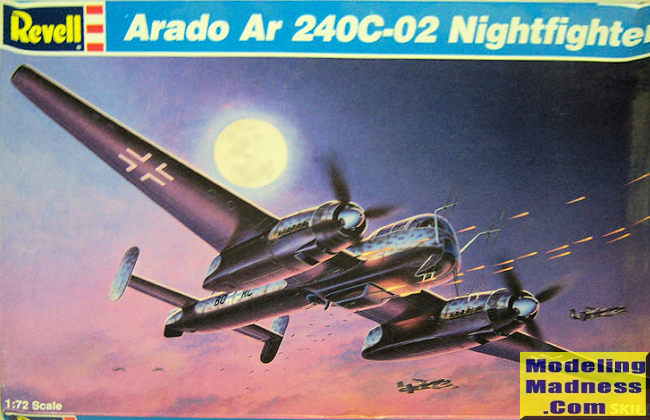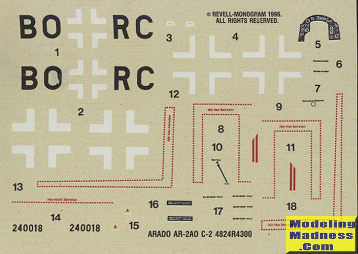
Revell 1/72 Arado Ar-240C-2 Night Fighter
| KIT #: | 4824 |
| PRICE: | $ |
| DECALS: | Two options |
| REVIEWER: | Scott Van Aken |
| NOTES: | 1996 boxing |

| HISTORY |
The Ar-240 was a response to a request for a heavy fighter to replace the Bf-110. The other entry, the Me-210 won the contract. In May 1939, the RLM ordered a batch of six prototypes. The first Ar 240 V1prototype, DD+QL, took to the air on 25 June 1940, and immediately proved to have poor handling in all axes, also tending to overheat during taxiing.
The handling was thought to be the result of the ailerons being too small, given the thick wing, so the second prototype was modified to have larger ones, as well as additional vertical fin area on the dive brakes to reduce yaw. In addition, small radiators were added to the landing gear legs to improve cooling at low speeds, when the gear would normally be opened. Ar 240 V2, KK+CD, first flew on 6 April 1941, and spent most of its life at the factory in an experimental role.
Ar 240 V3 followed, the first to be equipped with the FA 9 rear-firing armament system, developed jointly by Arado and DVL, armed with a 7.92 mm (.312 in) MG 81Z machine gun. Ar 240 V4 was the first to include an operational dive brake, and flew on 19 June 1941. Ar 240 V5 and the V6 followed in December and January, including the upgraded FA 13 system, using two 13 mm (.51 in) MG 131 machine guns in place of the MG 81Z for a considerable boost in firepower.
The Ar 240's excellent performance quickly led to the V3, V5 and V6 being stripped of their armament, including the defensive guns, and used as reconnaissance aircraft over England, where no other two-seater could venture by 1942.
According to the kit instructions, the tenth prototype was modified into the night fighter variant in 1943 and tested. The later Ar-440 had four examples built, the first one being converted from one of the Ar-240 prototypes.
| THE KIT |
 This kit was developed in 1996
and is an update of the original 1994 kit of the prototypes. At this time , the mo
This kit was developed in 1996
and is an update of the original 1994 kit of the prototypes. At this time , the mo deling world was deep in the
throes of 'luft 46. That justified the cost of tooling for this variation, but I
think this and the origianl boxing were it. I do know that this kit can easily
be found even 20 plus years after release so apparently it was not that great a
seller. The night fighter does away with the ducted
spinners, adds the radar gear, includes a lower fuselage gun pack, provides four
blad props has longer outer wings and it looks like the rear fuselage is a bit
longer as well. Enough bits to provide most of a new sprue. I've shown
that old sprue layout on the left and on the right, the new sprue still in the
bag as I didn't want to open the bag. Some of the salient bits not too easily
seen have been circled
deling world was deep in the
throes of 'luft 46. That justified the cost of tooling for this variation, but I
think this and the origianl boxing were it. I do know that this kit can easily
be found even 20 plus years after release so apparently it was not that great a
seller. The night fighter does away with the ducted
spinners, adds the radar gear, includes a lower fuselage gun pack, provides four
blad props has longer outer wings and it looks like the rear fuselage is a bit
longer as well. Enough bits to provide most of a new sprue. I've shown
that old sprue layout on the left and on the right, the new sprue still in the
bag as I didn't want to open the bag. Some of the salient bits not too easily
seen have been circled  Instructions
are identical to the RoG offering except that they add in the two steps for the
antenna and the gun pack. Colors in generic and ProModeler paints (which I've
never seen). The scheme is standard night fighter stuff of the mid-late war in
terms of an overall lighter grey upper with lots of mottles and a black
undersurface. Decals are nicely printed and the instructions warn not to use any
setting solutions on them. They are for the single aircraft. Again, no swastika
even though this is a Revell USA boxing.
Instructions
are identical to the RoG offering except that they add in the two steps for the
antenna and the gun pack. Colors in generic and ProModeler paints (which I've
never seen). The scheme is standard night fighter stuff of the mid-late war in
terms of an overall lighter grey upper with lots of mottles and a black
undersurface. Decals are nicely printed and the instructions warn not to use any
setting solutions on them. They are for the single aircraft. Again, no swastika
even though this is a Revell USA boxing.| CONCLUSIONS |
Like the earlier aircraft kit previewed, it is a nice looking plane and is something that is different from the norm of the average Luftwaffe builder. Worth the time and effort I'd say.
| REFERENCES |
https://en.wikipedia.org/wiki/Arado_Ar_240
September 2018 Copyright ModelingMadness.com. All rights reserved Thanks to me for buying this one to show you. If you would like your product reviewed fairly and fairly quickly, please contact the editor
or see other details in the
Note to
Contributors. Back to the Main Page
Back to the Review
Index Page
Back to the Previews Index Page